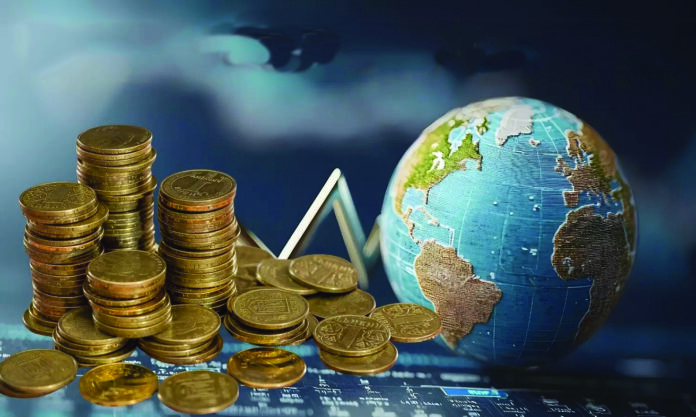International Monetary Fund’s (IMF’s) flagship report ‘World Economic Outlook [WEO] Update’, and titled ‘global growth: divergent and uncertain’, which was released in January 2025 takes a rightly cautious approach with regard to economic outlook globally, as it highlighted divergent growth possibilities overall, as follows: ‘The global economy is holding steady, although the degree of grip varies widely across countries. Global GDP growth in the third quarter of 2024 was 0.1 percentage point below that predicted in the October 2024 WEO, after disappointing data releases in some Asian and European economies. Growth in China, at 4.7 percent in year-over-year terms, was below expectations. …Growth in India also slowed more than expected, led by a sharper-than-expected deceleration in industrial activity. Growth continued to be subdued in the euro area (with Germany’s performance lagging that of other euro area countries), largely reflecting continued weakness in manufacturing and goods exports even as consumption picked up in line with the recovery in real incomes. In Japan, output contracted mildly owing to temporary supply disruptions. By contrast, momentum in the United States remained robust, with the economy expanding at a rate of 2.7 percent in year-over-year terms in the third quarter, powered by strong consumption.’
One reason that explains this with quite significance is the continued over-board emphasis on austerity policies to reduce inflation, whereby the policy rate cut is overall much slower than it should have been given a much fast pace at which inflation has come down. This is all the more true for developing countries like Pakistan, where although inflation is a little more than 4 percent, policy rate is still 12 percent!
It is, therefore, important that Pakistan rain-in over-board austerity policy stance, so that it can ease pressure on aggregate demand, and using much better governance-, and incentive structures, through pursuing reform policy much more aggressively through a more creative fiscal policy, especially on the aggregate supply-side, helps increase economic growth, on one hand, and more sustainably reduce inflation through reducing the build-up of inflation through cost-push-, and imported inflationary channels. Increasing economic growth is exceedingly important – as per the January 2025 WEO update, Pakistan’s economic growth is projected to grow by a paltry 3 percent in FY2024-25, and 4 percent in Fy2025-26, given a high population growth rate of around 2.4 percent, and high proportion of youth, or existence of youth bulge in overall population.
Hence, the global policy of Neoliberalism, especially in developing countries, and more so in those developing countries which this policy flows with all the vigour due to being under IMF programme, needs to move away from its policy of primarily using policy rate to reduce inflation, and in the process paying a lot of economic growth sacrifice, in particular in developing countries, which have all the more scope to use fiscal policy to reach better price discovery. Moreover, over-use of policy rate continues to constrain economic growth well after policy rate has possibly come down, due to the continued impact through monetary policy transmission unravelling over a number of months.
Not all countries though are following the path of over-cautious policy of keeping more than needed squeeze over aggregate demand, whereby both China, and India have given stimulus to the economy; China by following the policy whereby more than a trillion-dollar stimulus is being provided, and India in its recent months has reined in fiscal austerity measures, where taxes are being slashed. A February 3, Bloomberg published article ‘India’s record tax cuts to spur rebound, top official says’ pointed out in this regard ‘India’s economic growth slowdown is temporary and record tax cuts announced in the budget will help spur consumption and improve private investments in the world’s fifth-biggest economy, a top government official said. “It’s premature to say that we are destined to grow at 6.5% for the longer term,” India’s Chief Economic Adviser V. Anantha Nageswaran told Bloomberg TV’s Haslinda Amin in an interview on Monday. “When the global conditions change, we will grow at much higher rate.”’
As indicated above, developing countries in particular, where inflation is at least equally a fiscal phenomenon, and not just monetary phenomenon – although in developed countries as well, especially in the wake of global supply shock witnessed during the pandemic – there is need for unclogging the aggregate supply-side to create much-needed positive impact on reducing inflation, especially given over-using monetary austerity policy not only creates significant upward pressure on inflation through the channels of cost-push-, and imported inflation, high interest payment needs created in the process result in much greater debt burden, not to mention, the fiscal space squeezed as a process, likely resulting in curtailment of development spending, otherwise needed for enhancing economic growth, and economic resilience.
With regard to an innovative use of fiscal policy by Indian government in its recently announced Budget, another Bloomberg published article ‘Economists call India budget bold, much-needed “fiscal wizardry”’ pointed out ‘India’s finance minister walked the tightrope between boosting consumption and narrowing the fiscal deficit as the government attempts to bring a slowing economy back on track, according to economists. In her eighth budget on Saturday, Nirmala Sitharaman proposed tax cuts for low-income earners, while announcing a modest increase in infrastructure expenditure.’























